|
The Incredible Feather Book of 1618
Posted October 2016

Editor’s note: Almost 400 years ago, and centuries before John J. Audubon, Dionisio Minaggio in Milan, Italy, “self-published” a book depicting birds, hunters, tradesmen, musicians and comedians/actors. The aspect of the book that makes it most incredible—even beyond its publishing date of 1618—is the birds, animals, people, trees, tools, weapons, buildings and foliage created on its pages are made almost entirely of birds’ feathers. This artistic treasure has 156 pages of feathered pictures of 113 birds, 16 hunters, 14 actors, eight musicians, four tradesmen and one landscape.
The following article is courtesy of the McGill University Library of Montreal, Canada.
The Feather Book was created by Dionisio Minaggio, the Chief Gardener of the State of Milan in 1618. We have no idea why he made it, although it has been suggested that it might have been a project to occupy his staff during the long winter months and to use up some of the feathers left over from the birds used in the kitchen. It has also been suggested that the project may have been commissioned by the Governor. At the time, Milan was under Spanish rule, and the Spaniards were familiar with feather art as it was done in Central and South America. Although the style and techniques used were quite different, it is possible that such works may have been an inspiration for this project.
The Feather Book is a collection of illustrations made completely of bird feathers—with a few added extras. The majority of the pictures represent the birds of Lombardy—the area of Italy around Milan. They are complete with beaks and claws and, in a few cases, you can also see the skin of the head underneath the feathers. They may, in fact, represent the oldest collection of bird feathers—as bird specimens—in existence. In one image, the bird is eating a chameleon and in another, the bird has its tongue out and is scooping up insects from the bark of the tree on which it is perched. In one case, the leaves of the tree are present. There are also a couple of parrots and a bustard1 (probably) which are not native to Italy, but the birds and/or their descriptions may have come from sailors visiting the city.
As well as the bird images, there are collections depicting hunters, tradesmen, musicians and Commedia del’Arte 2 characters.
We do not know what happened to The Feather Book between 1618 and the mid-1700s. By that time, though, it was in the collection of Taylor White, an English judge who was fascinated with natural history. It remained in his family until about 1920, at which time it was offered for sale by the British book dealer Dobell and was bought by Dr. Gerhard Lomer, the McGill Librarian.
|
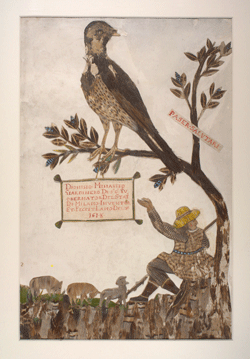
|
The Title Page
|
This is the first page of the original book, containing the author's name and the date of its execution. Represented here is a female Blue Rock Thrush, identified by the inscription, "PASER SALVTARI," placed on the branch of a tree which overhangs a pastoral scene with a shepherd and his flock. From a branch is suspended a cartouche bordered in green parrot feathers and tassels of gilded peacock plumes, containing the following inscription: “DIONISIO MINAGGIO GIARDINERO DE Sa Ea GUBERNADOR DEL STATO DI MILANO INVENTOR ET FECIT LANO DEL 1618” (Dionisio Minaggio, gardener to His Excellency the Governor of Milan was the creator, and he made [this book] in the year 1618).
The bird is much damaged, having lost most of its upper bill and many feathers from the head and breast. The shepherd indicates the cartouche with his left hand and carries a long staff in his right. He wears a hat of yellow and orange parrot feathers, hose and sleeves of duck feathers, and doublet made from the ventral feathers of a woodcock, the whole being set off by a belt of blue jay feathers. The meadow is made of various types of plumage including that of parrot, wild duck and grey partridge. The three grazing sheep (made of duck feathers) and the shepherd have fragments of spotted feather stuck on to simulate eyes.
The following are a few of the pages from The Feather Book.
|
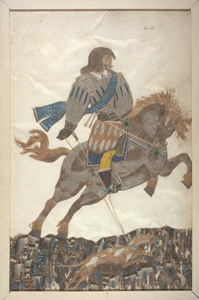
|
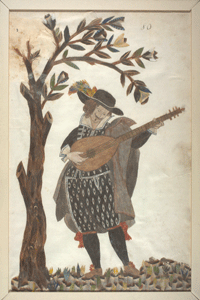
|
|
A gentleman riding a prancing horse and holding a hunting dog on a long lead.
|
A man with a moustache and goatee, playing an archlute.
|
|
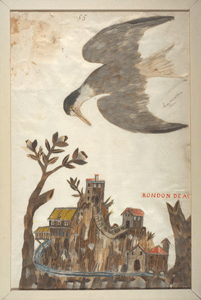
|
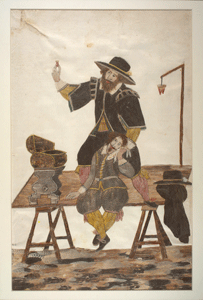
|
|
A Little, or Least, Tern flying over a landscape with trees, a rushing stream and several hilltop buildings. It is extremely unusual to see illustrations from this early a date showing birds in any other than a standing position.
|
Standing on a table between an open coffer and his professional insignia—an enormous tooth hanging from a pole—a tooth puller holds up the tooth he has just extracted from a suffering patient, who sits holding a blood-stained cloth to his face.
|
|
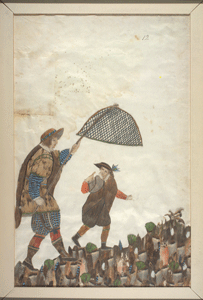
|
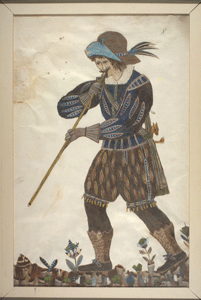
|
|
A man with a net and a boy walking towards a covey of five birds on the ground to the right.
|
Hunter using a blow-gun to shoot clay pellets at birds.
|
|
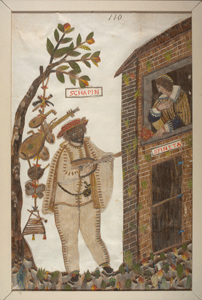
|
This picture shows an entire stage scene from a comedy written by Nicolo Barbieri—the serenading of the love-struck servant Spineta by the masked Schapin (Scapino). The variety of instruments hanging from the tree indicates that this is a depiction of the musically gifted actor and instrument designer Francesco Gabrielli and his wife Spinetta, who were members of the Confidenti company.
|
|
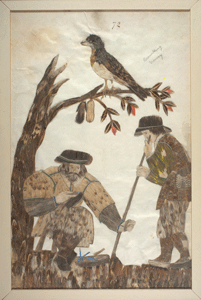
|
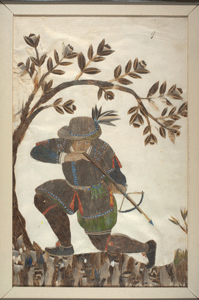
|
|
A cobbler repairs a shoe while its owner, with one stockinged foot and leaning on a long staff, waits. There is a Brambling perched in the tree above.
|
Man aiming a crossbow, used only for hunting large birds.
|
|
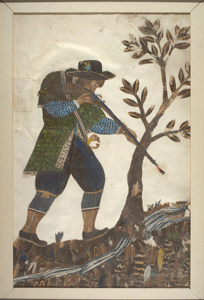
|
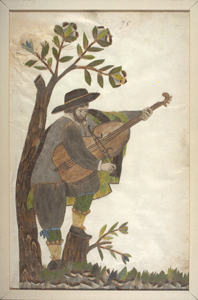
|
|
A hunter shooting an arquebus at a duck swimming in the river.
|
A bearded man, his foot braced on a stump, playing a cello.
|
|
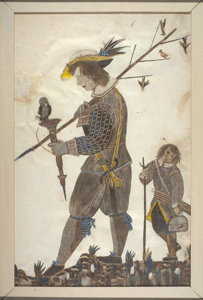
|
A hunter carrying a tethered owl on a portable perch and four song birds on a long pole over his shoulder. His assistant carries a caged bird and a quiver.
|
All of the incredible pictures in The Feather Book may be seen and enjoyed on the McGill University Library website at http://digital.library.mcgill.ca/featherbook/index.html.
------------------------
The article and all photos are courtesy of the Blacker-Wood Collection, Rare Books and Special Collections, McGill University Library and Archives.
1 A bustard is ground-running bird of the Old World and Australia that is related to the crane.
2 This term means “theater of the professionals.” It refers to improvised comedic sketches or theater plays that began in the 16th century in Italy and featured masked characters.
|